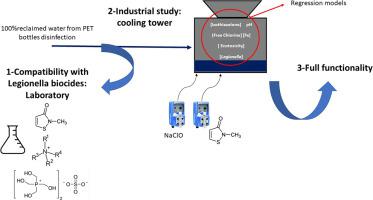Journal of Water Process Engineering ( IF 6.3 ) Pub Date : 2021-07-24 , DOI: 10.1016/j.jwpe.2021.102227 Borja Garrido Arias 1, 2 , Noemí Merayo 3 , Alejandro Millán 2 , Carlos Negro 1

|
Cooling water circuits represent a high-water saving potential that has not been fully exploited yet due to the risk of Legionella outbreaks. According to legislation, cooling circuits are subjected to specific biocide treatments which must be considered when water reuse is planned. Biocide effectiveness mainly depends on the type of installation, its operating regime, and the interactions with other chemicals. Therefore, water reuse is critical because its physical, chemical and microbiological characteristics, beside deposit and corrosion problems, may reduce the biocidal power and produce a health risk. However, there is a lack of knowledge on the compatibility of reclaimed water with biocides, and on long-term maintenance problems. This paper validates the long term performance of an industrial cooling tower using reclaimed water, obtained after the treatment of bottle washing water. The compatibility study of the reused water with three non-oxidant commercial products from the TP11 group (quaternary ammonium, tetrakis hydroxymethyl phosphonium sulphate and isothiazolone) shows a reduction lower than 20% of the biocide efficiency between periodic additions. Isothiazolone-based biocide was tested with reclaimed water during 1 year at industrial scale, without detecting any problem. Results show that water quality was always within the values allowed by legislation and slightly better when using reclaimed water (lower ecotoxicity of the purge and higher biocidal residual concentration). With the reuse strategy, water savings of 3750 m3/y were obtained. Furthermore, to minimize the Legionella and corrosion risks, an optimal control of the cooling tower has been developed based on correlations.
中文翻译:

工业冷却回路中的再生水使用:与 TP11 杀菌剂的兼容性
由于存在军团菌风险,冷却水回路具有很高的节水潜力,但尚未得到充分利用爆发。根据立法,冷却回路要经过特定的杀菌剂处理,在计划水再利用时必须考虑到这一点。杀菌剂的有效性主要取决于安装类型、操作方式以及与其他化学品的相互作用。因此,水的再利用至关重要,因为其物理、化学和微生物特性,除了沉积和腐蚀问题,可能会降低杀菌能力并产生健康风险。然而,对再生水与杀菌剂的相容性以及长期维护问题缺乏了解。本文验证了使用再生水的工业冷却塔的长期性能,该再生水是经过洗瓶水处理后获得的。重复使用的水与来自 TP11 组的三种非氧化性商业产品(季铵、四羟甲基硫酸鏻和异噻唑酮)的相容性研究表明,定期添加之间的杀菌剂效率降低低于 20%。基于异噻唑酮的杀菌剂在工业规模的 1 年内用再生水进行了测试,没有发现任何问题。结果表明,水质始终在法规允许的范围内,并且在使用再生水时略好(净化的生态毒性较低,杀菌剂残留浓度较高)。采用回用策略,节水 3750 m 基于异噻唑酮的杀菌剂在工业规模的 1 年内用再生水进行了测试,没有发现任何问题。结果表明,水质始终在法规允许的范围内,并且在使用再生水时略好(净化的生态毒性较低,杀菌剂残留浓度较高)。采用回用策略,节水 3750 m 基于异噻唑酮的杀菌剂在工业规模的 1 年内用再生水进行了测试,没有发现任何问题。结果表明,水质始终在法规允许的范围内,并且在使用再生水时略好(净化的生态毒性较低,杀菌剂残留浓度较高)。采用回用策略,节水 3750 m获得了3个/y。此外,为了最大限度地减少军团菌和腐蚀风险,基于相关性开发了冷却塔的最佳控制。











































 京公网安备 11010802027423号
京公网安备 11010802027423号